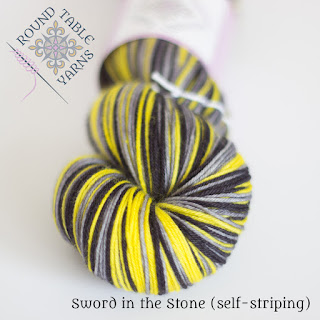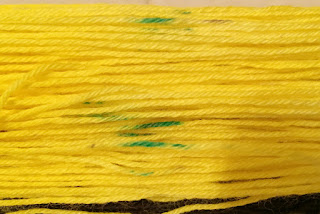I was dyeing some of the Sword in the Stone self-striping, which is yellow, grey, and black.
At the same time in another pot, I was dyeing a new teal colorway. When I took the Sword in the Stone out to dry, I noticed that, somehow, some of the teal dye had splashed onto the yellow section of Sword in the Stone!
I had three skeins of Sword in the Stone involved in this mishap and I was hoping that the teal was just on one or maybe two of the skeins. But when I reskeined the three skeins, there was teal on all three. What to do? Dye is transparent rather than opaque, so whatever is underneath a color will still show through (so I couldn't just redye those spots with yellow). I debated several options and decided that I'd try overdyeing the whole skein in teal.
This is how it came out (before and after). You can see some of the yellow still coming through the teal.
At first, I was just going to have these three skeins be a Quest colorway (meaning not repeatable), but I got a lot of positive response on this colorway on Instagram and at the Blackland Prairie Artisan and Fibre Faire last year. And all three skeins sold quickly. So I've given this colorway a name, and will occasionally offer it in the shop and at festivals. And if it's not available, but you do see some Sword in the Stone in the shop, just let me know that you'd like this overdyed version, and I'd be happy to dye it for you.
This color is now The French Book Saith.
Why that name? It comes from Malory's Morte D'Arthur. While Sir Thomas Malory was in prison (in the 15th century in England), he used the time to write the story of King Arthur, which became one of the greatest works of Arthurian literature. He used various source material while writing his version, including some French sources. Throughout the Morte, Malory often introduces material with the words "as the French book saith"; however, most of the time when Malory uses that phrase, when checking his French sources, scholars have found that the French book did not actually say what Malory claims it did.
In the Middle Ages, having source material and proving that you were using the source material was actually a way of legitimizing the text being written. Although stories were certainly created "from scratch," most stories were different versions of a prior story (and many scholars, including myself, spend a lot of time comparing versions to see what is different, which is usually where commentary and analysis come into play). So for Malory, using this phrase would give legitimacy to what he was writing, even when (especially when) the text was something Malory was introducing into the story rather than something from his source material.
So I felt this name was appropriate for this overdyed yarn since it is technically a version of one of the other colorways and yet at the same time is something all on its own.
~~~~~~~~~~~~~~~~~~~
The content in this post was first featured in my newsletter (November 5, 2015). If you'd like to keep up to date on my designs and yarn and receive content like this right in your email inbox, make sure to subscribe to my newsletter.





No comments:
Post a Comment